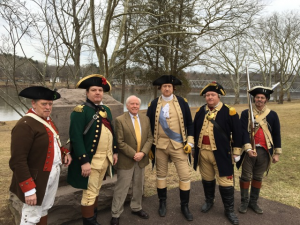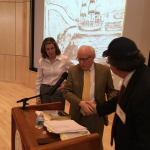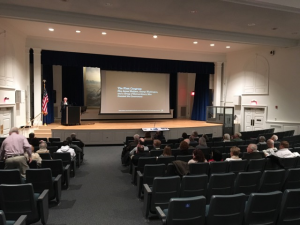As I drove here from Richmond to Hampden-Sydney College, I could scarcely help but feel enfolded in history. I passed close to Tuckahoe on the James River, where Thomas Jefferson lived as a boy. I followed the line of Lee’s retreat and Grant’s march to final victory in the Civil War. Now we’re gathered on this lovely campus whose founders inspirited generations of students with values that are inextricably interwoven with the founding of this nation. This enfolding sense of history reminds me how close we are to our nation’s past. But it also reminds me how far many of us today feel from the ideals that animated our forebears in their effort to craft an enduring and virtuous government.
Increasingly, it seems, Americans are fracturing culturally, economically, politically, and spiritually. Anxiety, discontent, and distrust of our fellow Americans have become the common currency of public discourse. Political speech has shrunk to sound bites and tweets. Our grasp of basic grammar – the architecture of clear expression – has disintegrated. Language once fitted for locker rooms, if even there, sprouts on protest placards and from the mouths of national leaders. Popular culture saturated with coarseness masquerades as creativity. What passes for news on television and online too often trivializes complexity, distorts the truth, inflates personality, and delivers ideological combat instead of penetrating reportage.
As we all know, I think, education in civics and government has foundered over the last half-century. Countless young – and even not so young – Americans no longer know the difference between the Senate and the House of Representatives, how a bill becomes law, or understand the way power is shared between Congress and the president. It increasingly seems that, in presidential elections, many Americans of all political stripes feel they are choosing an autocrat who can do what he wants once he takes office, and they react with fury when the balancing machinery of republican government prevents him from doing so. Ignorance guarantees disappointment with the inevitably messy way that compromise politics actually works. And such disappointment with what the Founding Fathers bequeathed us invites the demagoguery – of whatever persuasion — that the Founders rightly feared. This kind of ignorance and corrosive disappointment is not something that America can long afford.
Contempt for fundamental democratic institutions has become commonplace, and support for Congress and the established press has fallen to an all-time and deeply concerning low. Confidence in the ability of seasoned politicians to make the decisions that are necessary for the nation’s welfare has shriveled. We long for examples of constructive, creative, capable government, but don’t find them. Where, we might wonder, as many Americans do, are our Washingtons, our Madisons, our Hamiltons? Where are we to find great conciliators and compromisers like Henry Clay, and moral giants such as Martin Luther King, when we so sorely need them? We might be forgiven for believing that the nation is at one of the most dire points in its history.
While history may not offer much immediate solace in a time of trial, the past can nonetheless illuminate our path through the wilderness of the political moment by reminding us that our ancestors overcame many challenges even more fraught with danger than those we face today. History also encourages us to remember that the seeming giants of the past were not demigods but men as challenged by the crises of their time as we are today. Charles Francis Adams – the great-grandson of John Adams — once said: “We are beginning to forget that the patriots of former days were men like ourselves, acting and acted upon like the present race, and we are almost irresistibly led to ascribe to them in our imaginations certain gigantic proportions and superhuman qualities, without reflecting that this at once robs their character of consistency and their virtues of all merit.” Those words were written in 1871. They are, if anything, even more apt today.
Take James Madison, one of the charter trustees of this college. He was physically unimpressive, decidedly lacking in charisma, and spoke in a whispery, difficult-to-hear voice. Yet he consistently impressed those who worked with him with his “most ingenious” clarity of mind, his powers of persuasion, his willingness to listen to others, and his determination to make the imperfect machine of government work. No other man contributed more to the intellectual bedrock of our government. Brilliant as he was, he suffered several major defeats at the Constitutional Convention: he had proposed that the president be chosen by the legislative branch, that Congress be given the right to override state laws, and that the membership of both houses of Congress be based on population. On each of these he was defeated. Yet he went on, unbowed, to implement the Constitution on the parliamentary battleground of the First Congress.
The First Congress met only months after the ratification of the Constitution, first in New York and then in Philadelphia, from 1789 to 1791. The challenges facing the nation were immense. The United States was a shaky collection of eleven sovereign states – North Carolina and Rhode Island hadn’t yet joined the union yet. (Congress almost dispatched troops to march on Rhode Island, to carry out “regime change” in Providence.) Opponents of the new Constitution – including Hampden-Sydney charter trustee Patrick Henry — were demanding hundreds of amendments. The government had no reliable source of revenue. More than fifty different currencies were in circulation. (Thomas Jefferson had to change money every time he crossed a state line on his journey from Monticello to New York.) There was no permanent capital. Southerners were suspicious of northerners, westerners of easterners, and New Englanders of everyone else. There were well-founded fears that the trans-Appalachian West would break off into another country, or maybe several. The British threatened the fragile new nation from the north, Indian nations from the West, and the Spanish from the South. Quakers were demanding an end to slavery, while southerners threatened secession if government dared to tamper with their “peculiar institution.” Even many members of Congress doubted that the government would survive its birth. It’s worth remembering that when Gorge Washington took the oath of office at his first inauguration, onlookers could see that his hands were shaking. It wasn’t because of age: he feared that he wasn’t up to the task he faced. As Madison, who dominated the first crucial session of the First Congress, put it, “We are in a wilderness without a single footstep to guide us.”
In the teeth of such adversity, the First Congress achieved the most prodigious output of any single Congress in American history. It established the executive departments, the federal court system, the first revenue streams for the national government, approved the first amendments to the Constitution, adopted a program for paying the country’s debts and embraced the principles of capitalism as the underpinning of government financial policy. It also founded the first National Bank, established the national capital on the Potomac River, enacted the first patent and copyright laws, founded the United States Coast Guard, and much more.
How did they achieve all this? It wasn’t with a group hug. They did it largely through contentious debate and pragmatic, occasionally shameless, deal-making. Perhaps the best known compromise – now famous thanks to a certain well-known musical – took place at Thomas Jefferson’s home on Maiden Lane, in the heart of today’s financial district, in New York. There, in June 1790, Madison agreed to supply a certain number of very grudging votes from his friends in Maryland and Virginia in order to enact Alexander Hamilton’s far-reaching financial plan. In return, Hamilton a proto-abolitionist who favored a free-state capital, agreed to trade votes from his supporters in the North for the establishment of the seat of government securely in the slave states of Maryland and Virginia. It was, in essence, the first “backroom deal” in American history.
By today’s unrealistic standards, such swapping of votes at the expense of principle might seem reprehensible. But it required both character and courage on the part of the men involved. And the nation was the better for it.
Most of the members of that First Congress were not so different from the men and women who populate Capitol Hill today. Most were professional politicians, a majority were lawyers, and there was a good deal of chaff along with the human grain. They differed deeply from each other on many issues – slavery, centralized government, financial policy, regional interests, taxation. But every one of them wanted the government to succeed. They also believed in politics as a tool for national survival. After all, the right to be political was what they had fought the Revolutionary War for. The usually astute French ambassador, Louis-Guillaume Otto, rather cynically remarked in 1790: “The intrigues, the cabals, the underhanded and insidious dealings of a factious and turbulent spirit are even much more frequent in this republic than in the most absolute monarchy.” But the turbulence he was describing was just republican government at work.
The urgencies of transactional politics aside, Madison and his colleagues also believed in persuasion over power-driven argument, in accommodating divergent views, and in a willingness to make painful compromises for the greater good. Put another way, they relied on their own character, on their trust in the character of their fellow men, and on the kind of humane values that are deeply rooted here at Hampden-Sydney.
Americans today bemoan political partisanship, not entirely without reason. But partisan battles in the early republic could be savage, too. Take the struggle for the first amendments. We rightly think of the Bill of Rights as one of the most majestic components of our constitutional system. But many members of the First Congress didn’t want them at all. Federalists complained that tampering with the new Constitution would “throw everything into confusion.” Others argued that if the Constitution was treated as something “sacred” and untouchable what was the point of permitting amendments at all? Madison took on the responsibility of compressing the more than two hundred proposed amendments down to twelve, of which ten would ultimately be ratified as the Bill of Rights, although it was never called that then. No one at the time was happy with the result. South Carolina Congressman Aedanus Burke complained that the amendments that were finally enacted were “little better than whip-syllabub, frothy and full of wind, formed only to please the palate.”
We sell the founders short when we imagine that today’s messy political battlefields cannot also produce results that may also be of lasting value. And we sell ourselves short when we imagine that the men and women like us who represent us today are somehow made of lesser human material than our ancestors.
No one opposed the new government, the Constitution, and Madison more vigorously than Patrick Henry, the governor of Virginia, and the country’s paramount advocate for the rights of states against strong central government. Frankly, he hated the Constitution. “The principles of this system are extremely pernicious, impolitic, and dangerous,” he declared in 1788, predicting that the new government it created would “oppress and ruin the people.” The following year, he did everything he could to sabotage Madison’s election to Congress. But even Henry resigned himself to results that he had fiercely resisted. “Altho’ the Form of Government into which my Countrymen determined to place themselves had my Enmity, yet as we are one & all embarked, it is natural to care for the crazy Machine, at least so long as we are ought of Sight of a Port to refit,” he wrote to his protégé James Monroe after the close of the First Congress.
Both Madison and Henry were of course gentlemen of their time. But as Henry Adams implied, our ancestors had no monopoly on virtue. One of the most virtuous public men I have ever known lived not far from here, in Lunenberg County. His name was Nathaniel Lee Hawthorne. He was a World War II veteran who served in a racially segregated unit and was badly wounded in the Italian campaign. When I met him in 1967, he was the county chairman of the NAACP. I was a college kid helping him to register disenfranchised African-American voters. He was threatened, harassed, shot at, and accused of crimes he never committed. His rectitude was quiet but unbreachable. He also possessed extraordinary physical courage. One day, he walked into the middle of a Ku Klux Klan rally on the steps of the county court house to prove that African Americans weren’t afraid of them. (I know all this because I was with him that day.) If ever a man had reason to despair of his country it was Hawthorne. But he believed fiercely in it, and – like Madison and Henry – he also believed in the moral fortitude of his fellow men. He was, in every respect, a gentleman. And his battle for fairness in Lunenberg County was not so very different in its essentials from the one that Madison and his colleagues waged in New York two hundred and twenty-seven years ago.
In government, times are always tough, and the future always uncertain. We may wish to return to a kinder and gentler, more inspiring, more honorable, or more enlightened time. But every age has been as fraught with anxiety and dread as our own. In a sense, we are always, in Patrick Henry’s words, “ought of Sight of a Port.” History can’t guarantee us that our future will be bright, or ensure that when the political wheel turns, as it must, it will restore our world as it was before. Rather, history tell us that our political reality was never trouble-free to begin with.
Times of trial are not something for us to fear: crisis also reveals the essential character of a man. We will continue to struggle for the ideals and policies that we believe in. But lasting victory can never be achieved without compromise, and compromise can never be achieved without respect for one’s adversaries. Madison knew it. So did Patrick Henry. So did Nathaniel Lee Hawthorne. When we despair, we would do well to turn to Madison and Washington, Henry Clay and Abraham Lincoln, Martin Luther King, and others like them who brought common values of fairness and tolerance to the political world that we live in. All of them faced crises that tried their souls. Times of crisis also give birth to creative solutions. Just because we cannot see them at the moment does not mean that they don’t exist.
For almost two hundred and fifty years Hampton-Sydney has been committed to shaping character that will endure, and not falter amidst the turbulence of the moment. Its mission to form good men and good citizens is today more urgently needed than ever, as we navigate the personal and public challenges that will inescapably emerge to confront us as our lived history unfolds. Its commitment to teaching and embodying the values of mutual respect, open-mindedness, clear reasoning, and clear language are the blood and sinews of our society. Civility will never become obsolete. Honor need not grow feeble with age. These benchmarks of Hampden-Sydney’s purpose will remain forever vital not just to the molding of its graduates’ character, but to that of the nation.





